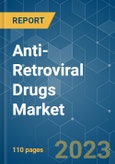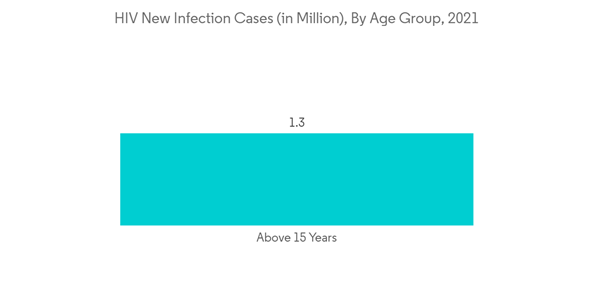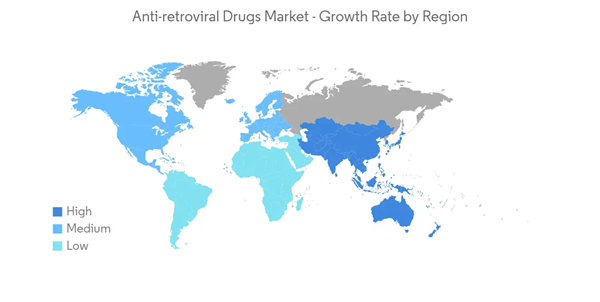The anti-retroviral drugs market is estimated to register a CAGR of 4.0% over the forecast period.
The COVID-19 pandemic impacted the growth of the anti-retroviral drug market. For instance, an article published by the journal GHSP in December 2021 reported that initially, some of the antiretroviral drugs were largely used for the treatment of COVID-19 and the rising COVID-19 infections surged the demand for these drugs. Thus, increasing COVID-19 cases led to increasing demand for antiretroviral drugs. However, in the current scenario, it is anticipated that a substantial decrease in COVID-19 cases due to the increased vaccination and availability of other drugs for COVID-19 treatment, and the studied market has lost some traction that was gained during the pandemic. However, the studied market is expected to have favorable growth due to the presence of other retrovirus infections over the forecast period of the study.
The factors driving the growth of the studied market are the rising burden of HIV, increasing investment in R&D, and an increase in the availability of novel drugs with better efficacy. For instance, in 2022, India's HIV Estimates Factsheet reported that the annual new infection (ANI) of HIV is estimated at 62.97 thousand in 2021 in India. Similarly, in July 2022 WHO reported that 38.4 million people are living with HIV in the year 2021. WHO also reported that the African region remains most severely affected, with nearly 1 in every 25 adults (3.4%) living with HIV and accounting for more than two-thirds of the people living with HIV worldwide. Also, according to WHO, HIV cases got significantly increased by 32.8% in the last two decades. Thus, rising cases of HIV are increasing the demand for antiretroviral drugs.
Also, the increased R&D expenses by various pharmaceutical companies are driving the growth of the studied market. For instance, in June 2022, GSK reported an investment of EUR 1 billion to accelerate R&D activities for the treatment of infectious diseases that disproportionately impact lower-income countries. The company reported that this research will focus on new and disruptive vaccines and medicines to prevent and treat HIV (through ViiV Healthcare), malaria, tuberculosis, and other infectious diseases, accounting for more than 60% of the disease burden in many lower-income countries. The news also reported that GSK Global Health R&D Hubs are progressing with more than 30 potential new vaccines and medicines, targeting 13 high-burden infectious diseases, including anti-retroviral drug infection. Thus, the increasing R&D expenses are driving the growth of the studied market.
Furthermore, the increasing availability of novel drugs for HIV treatment is driving the growth of the studied market. For instance, in June 2022, Gilead resubmiited new drug application for lenacapavir to the USFDA as a treatment for MDR HIV, lenacapavir is still only in phase 2 studies for treatment. Similarly, in March 2021, Gilead and MSD entered into a new partnership for developing long-acting formulations for the fight against HIV infections. Thus, such development of novel drugs and strategic collaboration between key market players are driving the growth of the studied market.
Thus, the rising burden of HIV, increasing investment in R&D, and availability of novel drugs with better efficacy contributes to the significant growth of the market. However, the side effects of drugs may slow down the growth of the study over the forecast period.
The increasing number of HIV cases globally and the effectiveness of multiclass combination product drugs for its treatment is increasing the demand for these drugs, thereby driving the growth of this segment. For instance, an article published by the journal Nanomaterials in February 2021 reported the significant results of using multiclass combination product therapy for reducing HIV symptoms. Similarly, the 2022 UNAIDS factsheet said that 38.4 million HIV infections were globally reported in 2021. The HIV cases increased by 1.6% compared to the previous year, 2020. Thus the increase in HIV cases coupled with the effectiveness of multiclass combination products for treating retroviral infection (HIV infection) is propelling the growth of this segment.
Furthermore, the new combination therapy approaches by various market players and institutes are also driving the growth of this segment. For instance, in November 2021, UK’s National Institute for Health and Care Excellence published a draft guidance recommending the country’s one of the first long-acting injectable treatments for HIV-1 infection in adults. The recommended treatment was a combination of the injections of cabotegravir with rilpivirine. NICE has recommended the combination as an option for adults with HIV-1 infection in those cases when antiretroviral medicines have kept viral loads to low levels, and there was no evidence of viral resistance. Thus, such guidelines for the newer treatment regime are expected to drive the growth of the studied market segment.
Thus, due to the rising burden of HIV cases and the advantages associated with multi-combination products for reducing HIV symptoms, the studied segment is expected to witness considerable growth over the forecast period.
The increasing number of HIV cases in North American countries demands an increasing need for anti-retroviral drugs. For instance, in February 2022, News Medical Lifesciences reported a new HIV outbreak in Tijuana, Mexico, driven in part by drug tourism unabated by the closure of the international border due to the COVID-19 pandemic. Similarly, in July 2022, Health Canada Statistics reported that an estimated 62,790 people were living with HIV in Canada at the end of 2020. Thus, a high number of people living with HIV and the increasing spread of HIV are increasing the demand for anti-retroviral drugs, thereby driving the growth of the studied market in the region.
Furthermore, drug approvals and product launches are also driving the growth of the market. For instance, in December 2021, the USFDA approved Apretude for use in at-risk adults and adolescents for pre-exposure prophylaxis (PrEP) to reduce the risk of sexually acquired HIV. Apretude is given first as two initiation injections administered one month apart, and then every two months thereafter. The safety and efficacy of Apretude to reduce the risk of acquiring HIV were evaluated in two randomized, double-blind trials that compared Apretude to Truvada, a once-daily oral medication for HIV PrEP. Thus, such approvals and new drug launches are propelling the growth of the studied market in the region.
Thus, due to the presence of key market players, technological advancements, and increasing research and development the market is expected to witness lucrative growth over the forecast period.
This product will be delivered within 2 business days.
The COVID-19 pandemic impacted the growth of the anti-retroviral drug market. For instance, an article published by the journal GHSP in December 2021 reported that initially, some of the antiretroviral drugs were largely used for the treatment of COVID-19 and the rising COVID-19 infections surged the demand for these drugs. Thus, increasing COVID-19 cases led to increasing demand for antiretroviral drugs. However, in the current scenario, it is anticipated that a substantial decrease in COVID-19 cases due to the increased vaccination and availability of other drugs for COVID-19 treatment, and the studied market has lost some traction that was gained during the pandemic. However, the studied market is expected to have favorable growth due to the presence of other retrovirus infections over the forecast period of the study.
The factors driving the growth of the studied market are the rising burden of HIV, increasing investment in R&D, and an increase in the availability of novel drugs with better efficacy. For instance, in 2022, India's HIV Estimates Factsheet reported that the annual new infection (ANI) of HIV is estimated at 62.97 thousand in 2021 in India. Similarly, in July 2022 WHO reported that 38.4 million people are living with HIV in the year 2021. WHO also reported that the African region remains most severely affected, with nearly 1 in every 25 adults (3.4%) living with HIV and accounting for more than two-thirds of the people living with HIV worldwide. Also, according to WHO, HIV cases got significantly increased by 32.8% in the last two decades. Thus, rising cases of HIV are increasing the demand for antiretroviral drugs.
Also, the increased R&D expenses by various pharmaceutical companies are driving the growth of the studied market. For instance, in June 2022, GSK reported an investment of EUR 1 billion to accelerate R&D activities for the treatment of infectious diseases that disproportionately impact lower-income countries. The company reported that this research will focus on new and disruptive vaccines and medicines to prevent and treat HIV (through ViiV Healthcare), malaria, tuberculosis, and other infectious diseases, accounting for more than 60% of the disease burden in many lower-income countries. The news also reported that GSK Global Health R&D Hubs are progressing with more than 30 potential new vaccines and medicines, targeting 13 high-burden infectious diseases, including anti-retroviral drug infection. Thus, the increasing R&D expenses are driving the growth of the studied market.
Furthermore, the increasing availability of novel drugs for HIV treatment is driving the growth of the studied market. For instance, in June 2022, Gilead resubmiited new drug application for lenacapavir to the USFDA as a treatment for MDR HIV, lenacapavir is still only in phase 2 studies for treatment. Similarly, in March 2021, Gilead and MSD entered into a new partnership for developing long-acting formulations for the fight against HIV infections. Thus, such development of novel drugs and strategic collaboration between key market players are driving the growth of the studied market.
Thus, the rising burden of HIV, increasing investment in R&D, and availability of novel drugs with better efficacy contributes to the significant growth of the market. However, the side effects of drugs may slow down the growth of the study over the forecast period.
Anti-Retroviral Drugs Market Trends
Multi-class Combination Product Segment is Expected to Register a Significant Growth Over the Forecast Period.
Based on drug class, the multiclass combination product segment is expected to register significant growth in the forecast years. The development of multiclass combination products is the rising burden of HIV and new drug approval. Also, many companies focus on developing breakthrough products for treating antiretroviral drugs to maintain their competitive advantage and penetrate new regional markets.The increasing number of HIV cases globally and the effectiveness of multiclass combination product drugs for its treatment is increasing the demand for these drugs, thereby driving the growth of this segment. For instance, an article published by the journal Nanomaterials in February 2021 reported the significant results of using multiclass combination product therapy for reducing HIV symptoms. Similarly, the 2022 UNAIDS factsheet said that 38.4 million HIV infections were globally reported in 2021. The HIV cases increased by 1.6% compared to the previous year, 2020. Thus the increase in HIV cases coupled with the effectiveness of multiclass combination products for treating retroviral infection (HIV infection) is propelling the growth of this segment.
Furthermore, the new combination therapy approaches by various market players and institutes are also driving the growth of this segment. For instance, in November 2021, UK’s National Institute for Health and Care Excellence published a draft guidance recommending the country’s one of the first long-acting injectable treatments for HIV-1 infection in adults. The recommended treatment was a combination of the injections of cabotegravir with rilpivirine. NICE has recommended the combination as an option for adults with HIV-1 infection in those cases when antiretroviral medicines have kept viral loads to low levels, and there was no evidence of viral resistance. Thus, such guidelines for the newer treatment regime are expected to drive the growth of the studied market segment.
Thus, due to the rising burden of HIV cases and the advantages associated with multi-combination products for reducing HIV symptoms, the studied segment is expected to witness considerable growth over the forecast period.
North America is Expected to Witness a Significant Growth Over the Forecast Period.
North America is expected to witness significant growth over the forecast period owing to the presence of key market players, technological advancements, and the presence of a high number of HIV cases.The increasing number of HIV cases in North American countries demands an increasing need for anti-retroviral drugs. For instance, in February 2022, News Medical Lifesciences reported a new HIV outbreak in Tijuana, Mexico, driven in part by drug tourism unabated by the closure of the international border due to the COVID-19 pandemic. Similarly, in July 2022, Health Canada Statistics reported that an estimated 62,790 people were living with HIV in Canada at the end of 2020. Thus, a high number of people living with HIV and the increasing spread of HIV are increasing the demand for anti-retroviral drugs, thereby driving the growth of the studied market in the region.
Furthermore, drug approvals and product launches are also driving the growth of the market. For instance, in December 2021, the USFDA approved Apretude for use in at-risk adults and adolescents for pre-exposure prophylaxis (PrEP) to reduce the risk of sexually acquired HIV. Apretude is given first as two initiation injections administered one month apart, and then every two months thereafter. The safety and efficacy of Apretude to reduce the risk of acquiring HIV were evaluated in two randomized, double-blind trials that compared Apretude to Truvada, a once-daily oral medication for HIV PrEP. Thus, such approvals and new drug launches are propelling the growth of the studied market in the region.
Thus, due to the presence of key market players, technological advancements, and increasing research and development the market is expected to witness lucrative growth over the forecast period.
Anti-Retroviral Drugs Market Competitor Analysis
The anti-retroviral market is fragmented due to many companies operating globally and regionally. The competitive landscape includes an analysis of a few international, as well as local companies which hold the market shares and are well-known, are AbbVie Inc., Boehringer Ingelheim International GmbH, Bristol-Myers Squibb Company, F. Hoffmann-La Roche Ltd, Gilead Sciences, Inc., Merck & Co, Inc., Viatris Inc. (Mylan Inc.), GlaxoSmithKline plc (ViiV Healthcare), Cipla Inc., Johnson and Johnson, Pfizer Inc. and Teva Pharmaceutical Industries Ltd.Additional benefits of purchasing the report:
- The market estimate (ME) sheet in Excel format
- 3 months of analyst support
This product will be delivered within 2 business days.
Table of Contents
1 INTRODUCTION
4 MARKET DYNAMICS
5 MARKET SEGMENTATION (Market Size by Value - USD million)
6 COMPETITIVE LANDSCAPE
Companies Mentioned (Partial List)
A selection of companies mentioned in this report includes, but is not limited to:
- AbbVie Inc.
- Boehringer Ingelheim International GmbH
- Bristol-Myers Squibb Company
- F. Hoffmann-La Roche Ltd
- Gilead Sciences, Inc.
- Merck & Co, Inc.
- Viatris Inc. (Mylan Inc.)
- GlaxoSmithKline plc (ViiV Healthcare)
- Cipla Inc.
- Johnson and Johnson
- Pfizer Inc.
- Teva Pharmaceutical Industries Ltd.
Methodology

LOADING...










